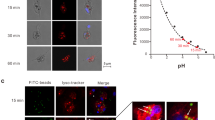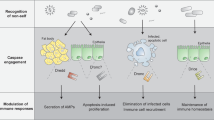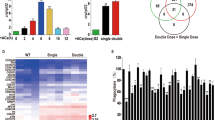Abstract
Phagocytes have a critical function in remodelling tissues during embryogenesis and thereafter are central effectors of immune defence1,2. During phagocytosis, particles are internalized into ‘phagosomes’, organelles from which immune processes such as microbial destruction and antigen presentation are initiated3. Certain pathogens have evolved mechanisms to evade the immune system and persist undetected within phagocytes, and it is therefore evident that a detailed knowledge of this process is essential to an understanding of many aspects of innate and adaptive immunity. However, despite the crucial role of phagosomes in immunity, their components and organization are not fully defined. Here we present a systems biology analysis of phagosomes isolated from cells derived from the genetically tractable model organism Drosophila melanogaster and address the complex dynamic interactions between proteins within this organelle and their involvement in particle engulfment. Proteomic analysis identified 617 proteins potentially associated with Drosophila phagosomes; these were organized by protein–protein interactions to generate the ‘phagosome interactome’, a detailed protein–protein interaction network of this subcellular compartment. These networks predicted both the architecture of the phagosome and putative biomodules. The contribution of each protein and complex to bacterial internalization was tested by RNA-mediated interference and identified known components of the phagocytic machinery. In addition, the prediction and validation of regulators of phagocytosis such as the ‘exocyst’4, a macromolecular complex required for exocytosis but not previously implicated in phagocytosis, validates this strategy. In generating this ‘systems-based model’, we show the power of applying this approach to the study of complex cellular processes and organelles and expect that this detailed model of the phagosome will provide a new framework for studying host–pathogen interactions and innate immunity.
This is a preview of subscription content, access via your institution
Access options
Subscribe to this journal
Receive 51 print issues and online access
$199.00 per year
only $3.90 per issue
Buy this article
- Purchase on Springer Link
- Instant access to full article PDF
Prices may be subject to local taxes which are calculated during checkout




Similar content being viewed by others
References
Greenberg, S. & Grinstein, S. Phagocytosis and innate immunity. Curr. Opin. Immunol. 14, 136–145 (2002)
Aderem, A. & Underhill, D. M. Mechanisms of phagocytosis in macrophages. Annu. Rev. Immunol. 17, 593–623 (1999)
Stuart, L. M. & Ezekowitz, R. A. Phagocytosis: elegant complexity. Immunity 22, 539–550 (2005)
TerBush, D. R., Maurice, T., Roth, D. & Novick, P. The exocyst is a multiprotein complex required for exocytosis in Saccharomyces cerevisiae. EMBO J. 15, 6483–6494 (1996)
Desjardins, M. ER-mediated phagocytosis: a new membrane for new functions. Nature Rev. Immunol. 3, 280–291 (2003)
Desjardins, M. & Griffiths, G. Phagocytosis: latex leads the way. Curr. Opin. Cell Biol. 15, 498–503 (2003)
Garin, J. et al. The phagosome proteome: insight into phagosome functions. J. Cell Biol. 152, 165–180 (2001)
Pearson, A. M. et al. Identification of cytoskeletal regulatory proteins required for efficient phagocytosis in Drosophila. Microbes Infect. 5, 815–824 (2003)
Ramet, M. et al. Drosophila scavenger receptor CI is a pattern recognition receptor for bacteria. Immunity 15, 1027–1038 (2001)
Ge, H., Walhout, A. J. & Vidal, M. Integrating ‘omic’ information: a bridge between genomics and systems biology. Trends Genet. 19, 551–560 (2003)
Vidal, M. Interactome modeling. FEBS Lett. 579, 1834–1838 (2005)
Bader, J. S. Greedily building protein networks with confidence. Bioinformatics 19, 1869–1874 (2003)
Bader, J. S., Chaudhuri, A., Rothberg, J. M. & Chant, J. Gaining confidence in high-throughput protein interaction networks. Nature Biotechnol. 22, 78–85 (2004)
Uetz, P. & Finley, R. L. From protein networks to biological systems. FEBS Lett. 579, 1821–1827 (2005)
Matthews, L. R. et al. Identification of potential interaction networks using sequence-based searches for conserved protein–protein interactions or ‘interologs’. Genome Res. 11, 2120–2126 (2001)
Asthana, S., King, O. D., Gibbons, F. D. & Roth, F. P. Predicting protein complex membership using probabilistic network reliability. Genome Res. 14, 1170–1175 (2004)
Cox, D. et al. Myosin X is a downstream effector of PI(3)K during phagocytosis. Nature Cell Biol. 4, 469–477 (2002)
Gold, E. S. et al. Amphiphysin IIm, a novel amphiphysin II isoform, is required for macrophage phagocytosis. Immunity 12, 285–292 (2000)
Colucci-Guyon, E. et al. A role for mammalian diaphanous-related formins in complement receptor (CR3)-mediated phagocytosis in macrophages. Curr. Biol. 15, 2007–2012 (2005)
Ramet, M., Manfruelli, P., Pearson, A., Mathey-Prevot, B. & Ezekowitz, R. A. Functional genomic analysis of phagocytosis and identification of a Drosophila receptor for E. coli. Nature 416, 644–648 (2002)
Boyd, C., Hughes, T., Pypaert, M. & Novick, P. Vesicles carry most exocyst subunits to exocytic sites marked by the remaining two subunits, Sec3p and Exo70p. J. Cell Biol. 167, 889–901 (2004)
Zhang, X. M., Ellis, S., Sriratana, A., Mitchell, C. A. & Rowe, T. Sec15 is an effector for the Rab11 GTPase in mammalian cells. J. Biol. Chem. 279, 43027–43034 (2004)
Prigent, M. et al. ARF6 controls post-endocytic recycling through its downstream exocyst complex effector. J. Cell Biol. 163, 1111–1121 (2003)
Bajno, L. et al. Focal exocytosis of VAMP3-containing vesicles at sites of phagosome formation. J. Cell Biol. 149, 697–706 (2000)
Niedergang, F., Colucci-Guyon, E., Dubois, T., Raposo, G. & Chavrier, P. ADP ribosylation factor 6 is activated and controls membrane delivery during phagocytosis in macrophages. J. Cell Biol. 161, 1143–1150 (2003)
Cox, D., Lee, D. J., Dale, B. M., Calafat, J. & Greenberg, S. A. Rab11-containing rapidly recycling compartment in macrophages that promotes phagocytosis. Proc. Natl Acad. Sci. USA 97, 680–685 (2000)
Clandinin, T. R. Surprising twists to exocyst function. Neuron 46, 164–166 (2005)
Mehta, S. Q. et al. Mutations in Drosophila sec15 reveal a function in neuronal targeting for a subset of exocyst components. Neuron 46, 219–232 (2005)
Desjardins, M., Huber, L. A., Parton, R. G. & Griffiths, G. Biogenesis of phagolysosomes proceeds through a sequential series of interactions with the endocytic apparatus. J. Cell Biol. 124, 677–688 (1994)
Acknowledgements
We thank R. Kearney and J. Bergeron from the Montreal Proteomics Network, and Genome-Quebec-Canada for their support. J.S.B., M.D. and R.A.B.E. thank their laboratories for their support. The work was supported by a Wellcome Trust Clinician Scientist Award to L.M.S., grants from the Whitaker Foundation and NIH/NIGMS to J.S.B, grants from the Canadian Institute for Health Research and Genome-Canada-Québec to M.D., and NIH grants to R.A.B.E. The work was conceived through discussions between the Laboratory of Developmental Immunology, Massachusetts General Hospital/Harvard Medical School and the Département de pathologie et biologie cellulaire, Université de Montréal. The bioinformatics and RNAi screens were performed in the Laboratory of Developmental Immunology, Massachusetts General Hospital/Harvard Medical School; the protein–protein networks were generated in the Department of Biomedical Engineering and High-Throughput Biology Center, Johns Hopkins University; the proteomics, the annotation of the components and the phagosome isolation were performed in the Département de pathologie et biologie cellulaire, Université de Montréal. Author Contributions L.M.S. and J.B. contributed equally to this work. J.S.B., M.D. and R.A.B.E. contributed equally to this work. The manuscript was written by L.M.S. and the website linked to this paper was designed by G.M.C.
Author information
Authors and Affiliations
Corresponding author
Ethics declarations
Competing interests
Reprints and permissions information is available at www.nature.com/reprints. The authors declare no competing financial interests.
Supplementary information
Supplementary information
This file contains Supplementary Methods, Supplementary Data, Supplementary Figures 1-5 and Supplementary Tables 2- 5 and Supplementary Table 9. (PDF 5985 kb)
Supplementary Table ST1
This file contains full list of proteins enriched in phagosome preparations isolated from Drosophila S2 cells . (XLS 1377 kb)
Supplementary Table ST6
This file contains results of RNAi screen for phagocytosis of E.coli and S.aureus. (XLS 314 kb)
Supplementary Table ST7
This file contains results of RNAi screen of the secondary components for phagocytosis of E.coli and S.aureus. (XLS 36 kb)
Supplementary Table ST8
This file contains plate and well i.d.s for MRC RNAi library primer. (XLS 129 kb)
Rights and permissions
About this article
Cite this article
Stuart, L., Boulais, J., Charriere, G. et al. A systems biology analysis of the Drosophila phagosome. Nature 445, 95–101 (2007). https://doi.org/10.1038/nature05380
Received:
Accepted:
Published:
Issue Date:
DOI: https://doi.org/10.1038/nature05380
This article is cited by
-
SUMO modification in apoptosis
Journal of Molecular Histology (2021)
-
Hemocyte phagosomal proteome is dynamically shaped by cytoskeleton remodeling and interorganellar communication with endoplasmic reticulum during phagocytosis in a marine invertebrate, Crassostrea gigas
Scientific Reports (2020)
-
InsP3R-SEC5 interaction on phagosomes modulates innate immunity to Candida albicans by promoting cytosolic Ca2+ elevation and TBK1 activity
BMC Biology (2018)
-
Participation of 14-3-3ε and 14-3-3ζ proteins in the phagocytosis, component of cellular immune response, in Aedes mosquito cell lines
Parasites & Vectors (2017)
-
Molecular imaging analysis of Rab GTPases in the regulation of phagocytosis and macropinocytosis
Anatomical Science International (2016)
Comments
By submitting a comment you agree to abide by our Terms and Community Guidelines. If you find something abusive or that does not comply with our terms or guidelines please flag it as inappropriate.



